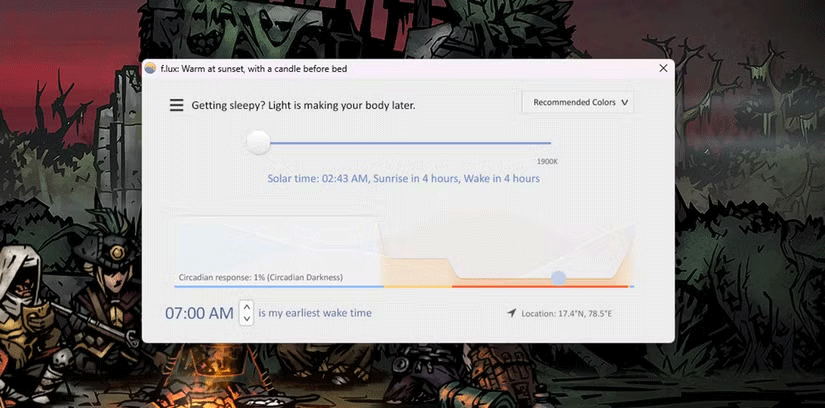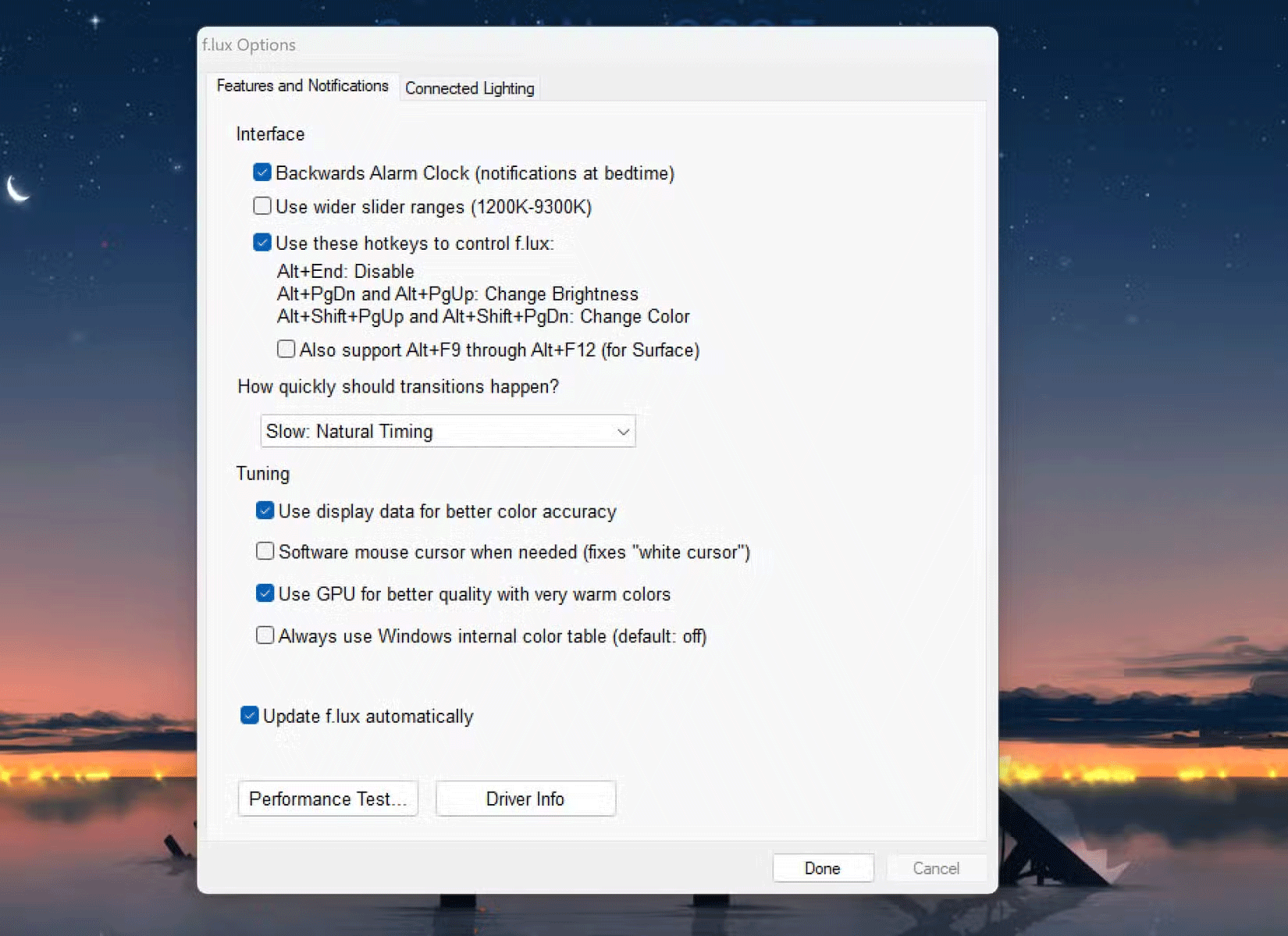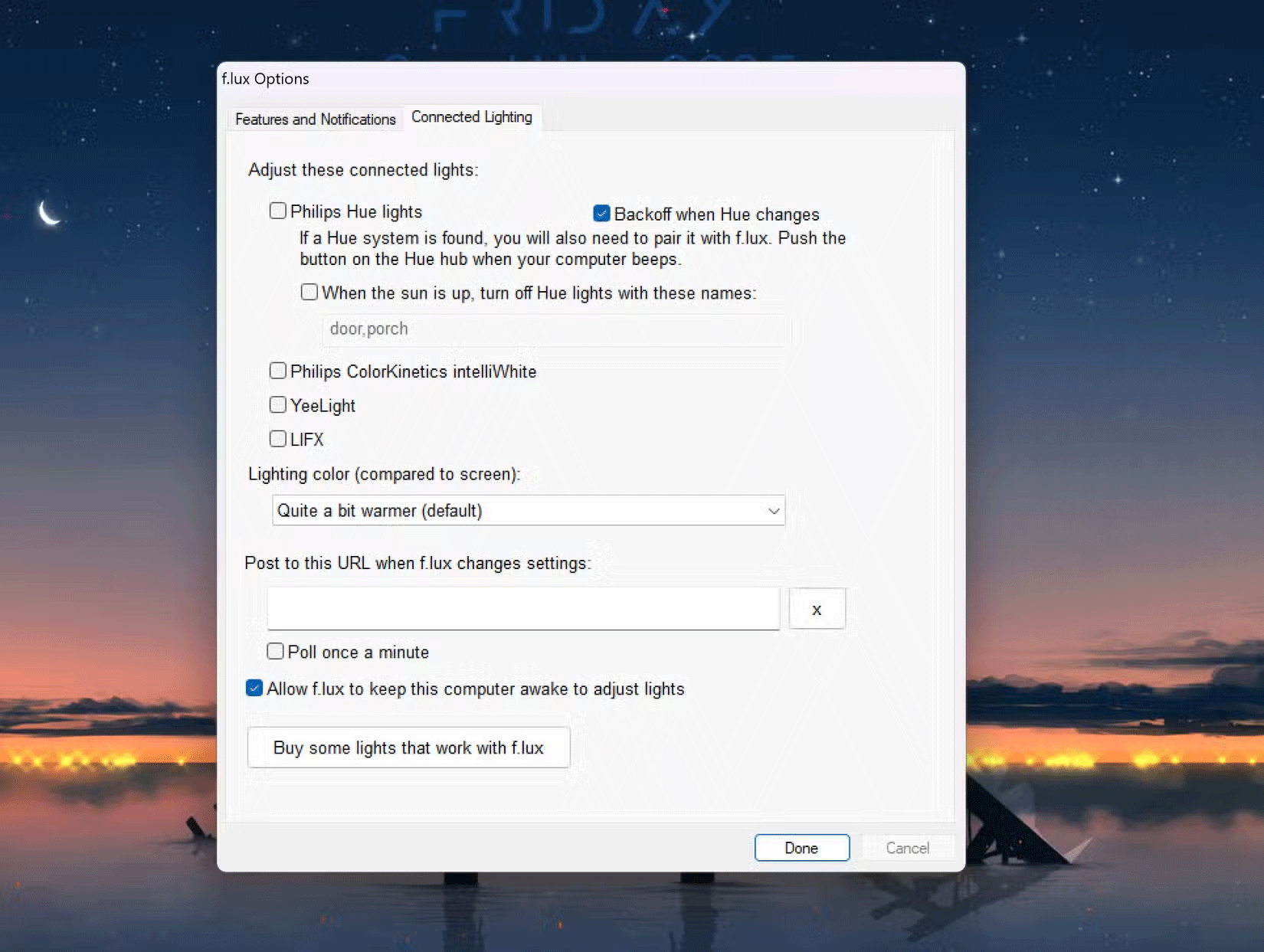Why use f.lux instead of Night Light on Windows 11?
Night Light on Windows 11 is a handy feature if you often use your computer at night, but it's not the best implementation of the feature. Many people use the free f.lux instead of Night Light on Windows 11; here's why.
1. f.lux has more customization options

The most common argument in favor of f.lux over Night Light is that f.lux has far more customization options than the native Windows implementation. You can change everything from the color temperature of your display to exactly when the color temperature changes and how often.
To be fair, the Windows implementation lets you set the intensity and schedule for Night Light to turn on, but f.lux takes it to the next level. You can choose presets for when the color temperature changes, like when you're working late or want to reduce eye strain.
Instead of just syncing with the sunrise and sunset at your location, f.lux lets you choose when you wake up to start using your computer and adjusts the color temperature accordingly. There are a lot of options for choosing the color temperature. With a little tweaking, you can get the most out of F.lux and protect yourself from blue light.
2. Night Light may interrupt full-screen apps
Many people have had bad experiences with Night Light and games—or more specifically, full-screen apps in general. The Windows implementation changes the screen color regardless of what you're doing. So if you're playing a game or watching a movie at night, your screen will inevitably turn yellow.
Many people have seen annoying behavior from Night Light with full screen apps. Sometimes games will run fine. Other times there will be a yellow tint on the screen and Night Light has to be turned off manually for it to go away.
However, f.lux handles full-screen apps much better. If you have a dual-monitor setup, f.lux will reset the color temperature on your primary monitor whenever a full-screen game or program is running. Meanwhile, f.lux maintains its colors on the second monitor—something the Windows feature doesn't do.
3. F.lux is more consistent

Adding to the previous point, f.lux is much more consistent in managing the color temperature of your desktop. Sometimes, if you shut down your PC with Night Light enabled, you may still find it enabled when you restart your computer, even in the morning.
The Windows feature also kicks in quite abruptly, simply changing the color temperature of your screen at the exact minute the sun sets. This change is extremely harsh on the eyes, compared to the smooth transition that f.lux provides. As the sun sets or rises, f.lux gradually changes the color temperature, so you don't even notice the change.
There are far fewer crashes, bugs, and glitches when using f.lux. Plus, it includes shortcuts to turn off services, change brightness, or adjust color temperature on the fly. So even if the program displays the wrong colors or doesn't switch automatically, you don't have to dig through menus.
4. F.lux can also control smart bulbs

Finally, F.lux comes with a ton of extra features that you won't find in Night Light. This includes the ability to sync your Phillips Hue smart bulbs with your desktop's color temperature, allowing for seamless transitions between day and night lighting.
You'll find these settings under the Connected Lighting tab in f.lux's preferences. You can set the light color based on your desktop and even choose which lights turn off when it's morning. This feature also works with Philips Color Kinetics intelliWhite, YeeLight, and LIFX lights.
Overall, f.lux is a free, easy-to-use, lightweight program that can be useful if you use your computer all the time at night. Changing the color temperature of your computer can also help you sleep better – the blue light our computers emit is not good for sleep, especially when you're staring at a screen at 3am.
You should read it
- How to fix the Night Light mode of Windows 10
- How to use Night Light mode in Windows 10?
- How to turn on Night Light mode on Windows 10
- How to use the Night Light feature on Google Pixel
- Enable to limit blue light from PC and Mac computer screens to protect sleep - did you know?
- Much more great option to replace Windows 10's Night Light feature
- How to enable Night Light mode to limit blue light on Chromebooks
- How to configure color temperature in GNOME Night Light
May be interested
- How to configure color temperature in GNOME Night Light
 it's good to have tools to change the colors of the monitor. there are many programs out there that do that. this article will introduce you to one of them and guide you on how to configure color temperature in gnome night light.
it's good to have tools to change the colors of the monitor. there are many programs out there that do that. this article will introduce you to one of them and guide you on how to configure color temperature in gnome night light. - Redeem feature Night Light for Android 8.0 Oreo on Nexus
 unfortunately for those who use android 8.0 oreo version on nexus devices because it lacks some features. one of the features that pixel owns, but the nexus doesn't have is the night light.
unfortunately for those who use android 8.0 oreo version on nexus devices because it lacks some features. one of the features that pixel owns, but the nexus doesn't have is the night light. - How to enable Night Mode on Samsung Galaxy S8
 night mode on samsung galaxy s8 has the ability to filter the blue light, causing the screen to have a softer light, reducing the impact on the user's eyes.
night mode on samsung galaxy s8 has the ability to filter the blue light, causing the screen to have a softer light, reducing the impact on the user's eyes. - 5 ways to get the most out of f.lux on Windows 10
 a popular choice for removing blue light from screens, the f.lux app has attracted interest from computer professionals around the world.
a popular choice for removing blue light from screens, the f.lux app has attracted interest from computer professionals around the world. - Blue light filtering applications must be available for your computer, phone
 green light is part of the visible light spectrum, acting deeper to the eyes and lasting can damage the retina. and it is related to the development of age-related macular degeneration, worst, it makes your brain awake when you're going to sleep. here are the 'must have software for people who work on computers at night to better protect their eyes, improve their health and productivity.
green light is part of the visible light spectrum, acting deeper to the eyes and lasting can damage the retina. and it is related to the development of age-related macular degeneration, worst, it makes your brain awake when you're going to sleep. here are the 'must have software for people who work on computers at night to better protect their eyes, improve their health and productivity. - Instructions for activating Night Shift on iOS 9.3
 prominent among them is a new feature, called night shift, which is useful for phone users at night, which is aimed at reducing the impact of ios screen light on sleep with the provision of ability to customize the screen blue intensity from darker to lighter.
prominent among them is a new feature, called night shift, which is useful for phone users at night, which is aimed at reducing the impact of ios screen light on sleep with the provision of ability to customize the screen blue intensity from darker to lighter. - Change these settings on your iPhone for stunning nighttime photos!
 iphone cameras have gotten a lot better over the years. these days, iphones take great night photos — but not by default. if your low-light shots look grainy or blurry, it's time to tweak your settings.
iphone cameras have gotten a lot better over the years. these days, iphones take great night photos — but not by default. if your low-light shots look grainy or blurry, it's time to tweak your settings. - Can the iPhone's Night Shift mode be damaging to user health?
 will night shift and similar features really work as advertised?
will night shift and similar features really work as advertised? - Activate Blue Light mode on Windows 10
 since windows 10 build 14997, windows 10 allows users to activate blue light mode to reduce stress and fatigue. when this feature is activated, the color gamut on the screen will reduce the blue light, making your eyes feel more comfortable at night.
since windows 10 build 14997, windows 10 allows users to activate blue light mode to reduce stress and fatigue. when this feature is activated, the color gamut on the screen will reduce the blue light, making your eyes feel more comfortable at night. - Akamai detected the Fast Flux botnet with 14,000 IP addresses
 researchers at akamai have discovered a botnet with more than 14,000 ip addresses used to spread malware, using smart technology called fast flux.
researchers at akamai have discovered a botnet with more than 14,000 ip addresses used to spread malware, using smart technology called fast flux.










 Does donating blood cause anemia?
Does donating blood cause anemia? How to enable Android System WebView
How to enable Android System WebView 6 Best Free Websites to Find Craft Ideas
6 Best Free Websites to Find Craft Ideas How to remove adware on computer
How to remove adware on computer Amazing facts about snow
Amazing facts about snow How to delete search history on Windows 11
How to delete search history on Windows 11